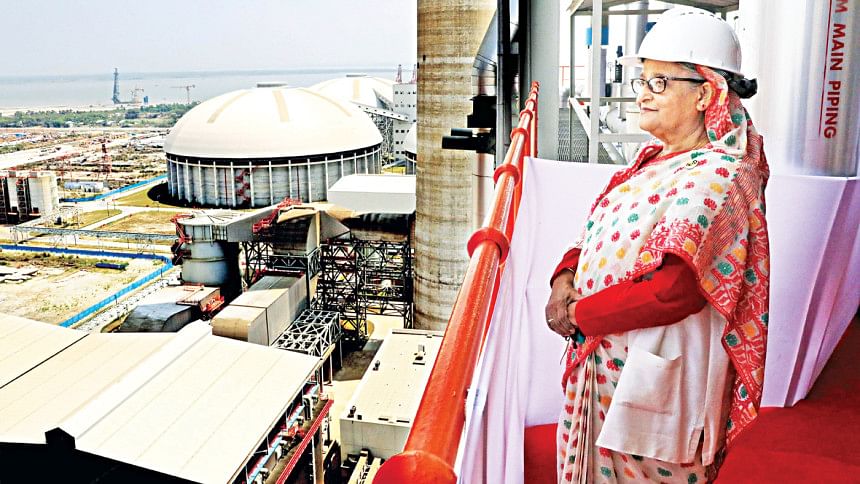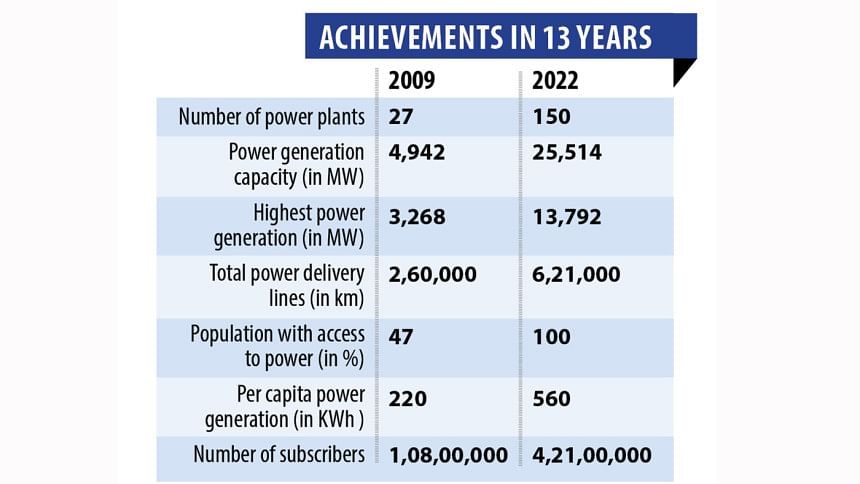Electricity now in every house

It's a milestone that can make the country proud.
From a mere 47 percent in 2009, Bangladesh has now ensured 100 percent coverage of electricity.
"Every house of the country now has access to electricity," Prime Minister Sheikh Hasina announced yesterday while officially inaugurating the 1,320 MW Payra Thermal Power Plant, the largest of its kind in country.

The PM said, "The biggest thing is that we have been able to illuminate houses of all the people."
She also said her government has managed to distribute power to every house of remote hilly and hard-to-reach areas by setting up solar panels, and to char areas through submersible cables.
Describing power as the driving force of the country's impressive development, the PM said for the last 13 years the government has been working tirelessly for the overall development of the power sector.
Inaugurating the coal-fired power plant, she said, "It's a gift from me to the people of the country ahead of Ramadan and the holy Eid-ul-Fitr."
The prime minister released 1,320 pigeons, the symbol of peace, after unveiling the plaque of the power plant in Patuakhali and went round the central control room of the plant.
In her first in-person speech since the outbreak of the Covid-19 pandemic two years ago, she thanked China's president and its prime minister for their cooperation in setting up the power plant.
Bangladesh is now ahead of India and Pakistan, which have brought 98 percent and 74 percent of their respective populations under the electricity network, according to data from the World Bank.
The power generation capacity has risen to 25,514 MWin February 2022 from 4,942 MW in January, 2009. Of them, 1,160 MW electricity is being imported and 19,626 MW is locally generated, according to data of the Bangladesh Power Development Board (BPDB).
Per capita power generation has increased from 220 kWh to 560 kWh and distribution losses of electricity have been cut by 5.85 percent.
The PM's Power, Energy and Mineral Resources Adviser Dr Tawfiq-e-Elahi Chowdhury, State Minister for Power, Energy and Mineral Resources Nasrul Hamid, Secretary of the power division of the ministry Md Habibur Rahman, and Ambassador of China to Bangladesh Li Jiming, spoke during the inauguration.
AM Khurshedul Alam, director general of Bangladesh-China Power Company (BCPC), delivered the welcome address.
Hasina said the people had been suffering from acute power crisis before the Awami League government assumed power in 1996.
She said for four years in their first term, power generation had increased to 4,300 MW from 1,500 MW during the tenure of the BNP government.
The prime minister said after 2001, the country had again fallen into acute power crisis as power generation was reduced to 3,200 MW.
Since assuming power for the second time in 2009, she said her government has been able to take the country on the highway to development.
She said Bangladesh is no longer dependent on others to set up power plants as local experts can use their experience and expertise gathered after installing power plants in joint collaborations.
Explaining the claim of 100 percent coverage, officials of the Ministry of Energy, Power and Mineral Resources said they provided connections to all who applied for it.
"We have electricity coverage in every area of the country either by national grid or the solar home system," said Mohammad Hossain, director general of Power Cell. "We have coverage, but if anyone didn't apply, we can't force them."
Some areas like Chittagong Hill Tracts where the national grid didn't reach, they had solar home systems. Some islands like Hatiya have engines to produce power locally, he added.
Around 4.21 crore connections have been provided till date, according to BPDB data.
Payra Plant
The $2.48 billion coal-fired power plant, using Ultra Supercritical Technology, is the 13th in the world and seventh in South Asia.
Ultra Supercritical Technology aims at protecting the environment in line with the government's policy, BPDB officials said.
After undergoing test runs for about five months, the first unit of the Payra power plant, a joint venture of Bangladesh and China, started commercial operations in May, 2020 and the second unit in October, 2020.
The Power Transmission Company of Bangladesh (PGCB) had undertaken a number of projects to distribute electricity from the Payra plant.
These projects include construction of a 160km 400kV double circuit line from Payra to Gopalganj, a 164.6km Aminbazar–Mawa–Gopalganj-Mongla 400 kV double circuit line and a 9.4km river-crossing line close to Padma Bridge.
PGCB officials said all these projects are targeting power distribution from both Payra and Rampal plants and will cost about Tk 4,650 crore, of which Tk 3,294 crore will be spent on the Payra plant's transmission facilities.
Officials of the Payra plant said they have been operating the two units in alternative months to keep the plant's equipment operational.
The authorities expected to supply about 80-85 percent of the plant's electricity to the southern part of the country.
Officials said the plant will be operated at full steam only once the 440kV transmission line is established through the Padma river.
The power plant is burning some 13,000 tonnes of coal a day. It has a 76.30 acre dumping zone where 25 years' worth of by-product can be kept.
The plant is currently importing coal from Indonesia. It has its own jetty whose conveyor belts can unload 3,200 tonnes of coal every hour from four vessels at the same time.
[With inputs from BSS and UNB]

 For all latest news, follow The Daily Star's Google News channel.
For all latest news, follow The Daily Star's Google News channel. 



Comments